HERALD RIDER’S SERIES #2 A conversation with Kordian Handzlik
At Herald we love seeing our motorcycles being put through their paces, tackling different terrains and challenges set before them. Our brand ethos has been epitomised by Kordian Handzlik and his past adventures through Morocco & Spain on his Herald Classic 125. While we are all beginning to plan our post lockdown adventures, we caught up with Kordian to get some inspiration and learn more about his breath-taking escapades on his Herald…
Q: How long have you been riding motorcycles?
First of all let me thank you for having this little conversation with me and let me say say hello to all who might be reading it. It’s a real pleasure to finally have a chance to talk about that trip, despite the fact it’s been two very long years since it took place. If it wasn’t for the pandemic, I’d probably have more new stories to tell, but thanks to you guys I can at least relive the memories.
Now to answer the question, I started riding quite late in my life compared to most of the riders I know – it was 2016, so five years ago and I just turned 30 at that time.
Q: Where did you first hear about Herald Motor Co?
Two years before coming to the UK I completed my motorcycle course in Poland, which took 30 compulsory hours of practical riding on 600cc bikes. Problem was that the motorcycle season ended before I got around to passing my test and right after the winter my wife and I decided to move to the United Kingdom.
Since I lost my chance to get a licence for big bikes, I found out that doing a CBT would be a great way to get back on two wheels quickly. That’s how I started searching for a small engine motorcycle that would look like a serious bike. I soon came across Herald and after seeing it in person I quickly fell in love with the Classic 125.
I believe Herald was a quite new brand on the market back then as there weren’t many reviews on the internet. The ones I found were all positive and what pulled me most towards Herald was the fact that although they had only just started importing these 125s they put an actual effort into improving the bikes and clearly cared about the customer’s experience. Herald definitely stood out and seeing how the company now participates at all those different bike events I can tell that I made the right choice.
And of course once I got the bike I kept hearing people saying things like “I had the exact same bike when I was young” or asking “Is that a Triumph?”. The little Herald proved to be such a wonderful head turner at a great price point and a wonderful base for customisation too. It started as a shiny black classic, two years later it became my army green “Lawrence of Arabia” type machine.
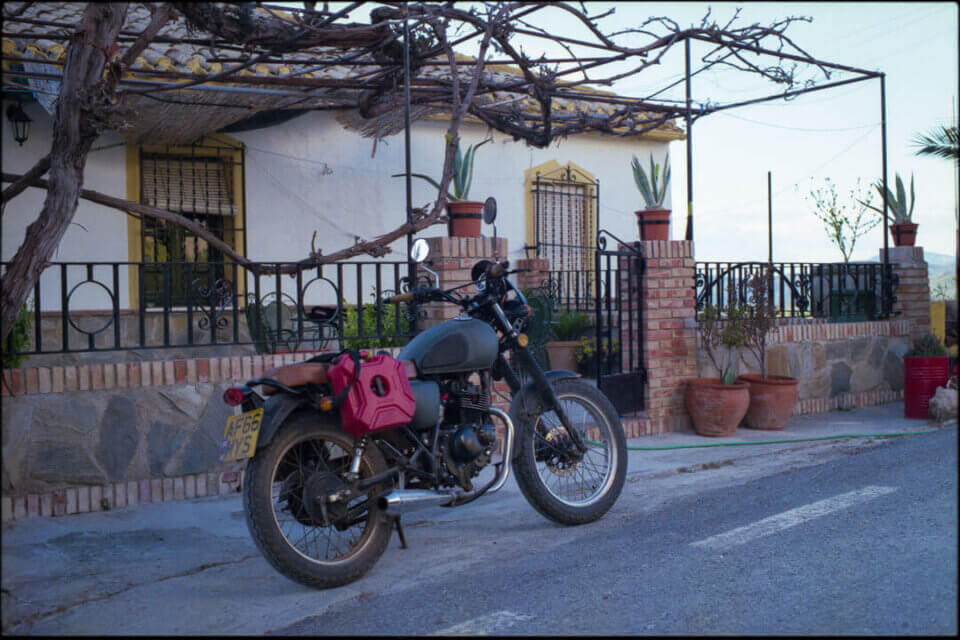
Q: What spurred you on to travel through Morocco & Spain on your Classic 125?
The trip was actually a reward to myself for the long and bumpy road I had taken to get my motorcycle licence. I couldn’t think of a better way to celebrate that success than to go on an adventure. Some would say a bigger bike should be the next step, but the travel bug inside me told me otherwise!
So once I passed my test in November I started planning the trip. I’ve been to Morocco twice before and I felt like it would make a really interesting and quite exotic destination. It’s far enough to be considered a challenge yet very close to Europe in case something goes wrong. And within a timeframe of 23 days I knew I could potentially reach any place there and still have that extra time for Spain. Eventually I even managed to go back through France rather than take a ferry from Spain like most people do.
Q: How did the Classic 125 handle the different terrains such as the sandy deserts of Morocco and dusty trails of Spain?
Like you say, I rode through so many different terrains and passed a couple of different climate zones, I feel like it would be a shame if I didn’t mention what my trusty Herald had to go through.
Once I left England, I arrived in Santander where I had to take some twisty mountain roads surrounding the north coast of Spain. It was early March so still quite cold and it happened to be one of two rainy days during my whole trip. After I left the Cantabrian mountains it took me roughly three days till I got to Morocco. I chose the easiest route by simply going south – the roads were really beautiful, in Valle del Jerte or at the border of Extremadura and Andalucia especially.
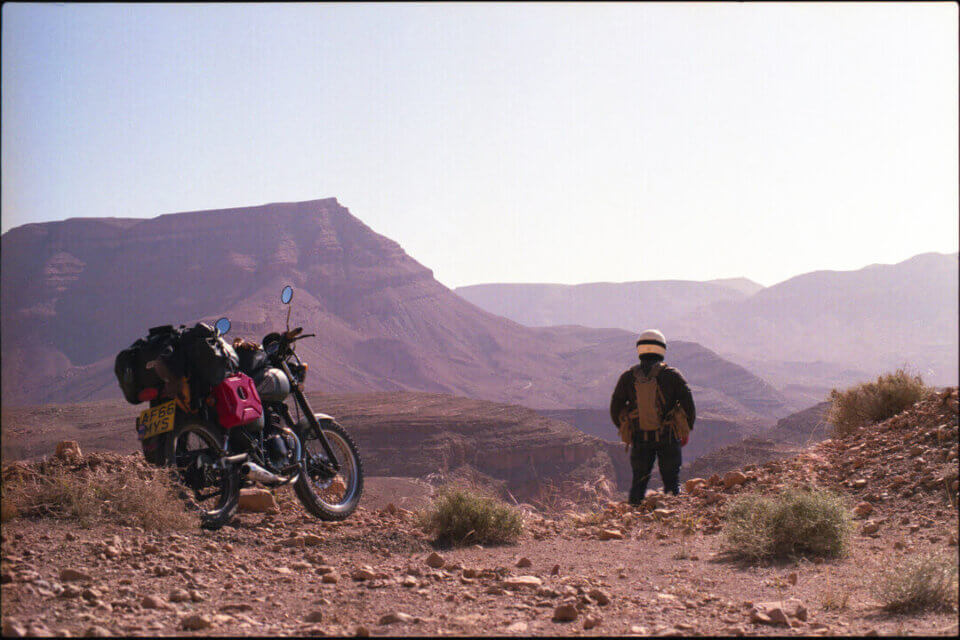
I was covering 200-270 miles to get from point A to B which was taking me roughly 7-9 hours of riding including some small breaks. It was a real test of endurance not only for Herald’s little engine but also for me. I usually had to wake up around 5 in the morning and hit the road before the sunrise. I always tried to arrive before dinner time, get familiar with the area where I was staying and do some shopping for the next day.
I dropped daily mileages down a bit once I crossed the Strait of Gibraltar and got to North Africa, yet still covered around 1500 miles within ten days making a huge loop around Morocco. After arriving in Tanger Med, I rode south to the famous blue city of Chefchaouen and then kept going south through various little towns until I reached the breathtaking Ziz Valley and later on Merzouga – a place they call the gate to Sahara. The dunes had such an unusual golden colour and I couldn’t resist riding into the sand. Once I did, I actually got stuck while scorching heat poured out on me from the cloudless sky. I blamed my own foolishness rather than the road tyres I was riding on, but either way instead of taking a cool photo in the desert I ended up cursing and sweating to get the bike out of the sand. And I left the town as soon as I did.
Merzouga was the southernmost point of my trip and now I headed west. The main challenge was to get through the south side of the Atlas Mountains and eventually to cross the range and get to Marrakech. Still hot and very desert-like but also high on altitude with various mountain passes on the way. I managed to visit two well known gorges – Todra and Dades, went to the Atlas Studios in Ouarzazate where some of the decorations from Ridley Scott’s movies are still on display and after passing Ait Benhaddou and Telouet villages I eventually crossed the Atlas and ended up in Marrakech. After thirteen days of constant riding I could finally take a day off and from then on I was in retreat. Next day I went up north and within two days I closed the loop in Tanger where I caught a ferry and welcomed the Spanish coast again.
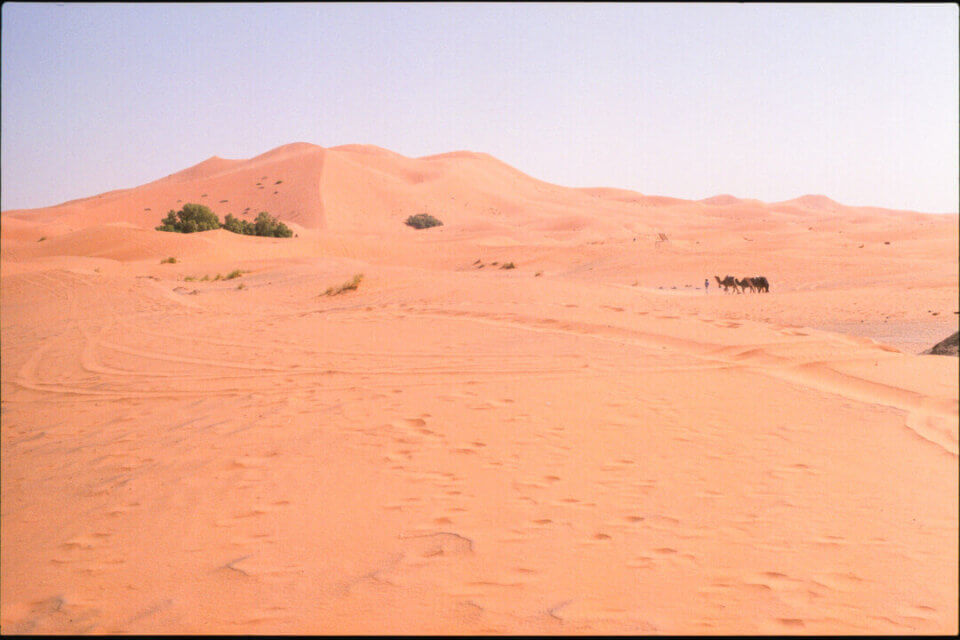
This time I gave myself six days for Spain, most of which I spent in Andalucia. The region was so beautiful that I really hope to go back there again someday. The west is covered with mountains and tiny whitewashed villages they call los pueblos blancos, while the east is home to the Tabernas desert. I’m a huge fan of classic movies, so I went to the desert with a particular goal in mind to find a place where Sergio Leone directed his famous spaghetti western – “The Good, the Bad and the Ugly”. Soon after I found the exact spot where Clint Eastwood split his bounty money with Tuco, I jumped back on the bike and went to Sorbas – another less known town where this time Jack Nicholson played in Michelangelo Antonioni’s “The Passenger” back in 1975 (I highly recommend seeing both movies). What a wonderful day it was!
But as the old saying goes all good things come to an end. Once I covered both west and east Andalucia I had to turn north and head towards Pamplona to cross the western part of Pyrenees and get to France. I stopped briefly in Bardenas Reales badlands and spent a few nights in some lovely places but other than that it was just four days on a full throttle till I got to northern France where I caught a short ferry ride to Portsmouth.
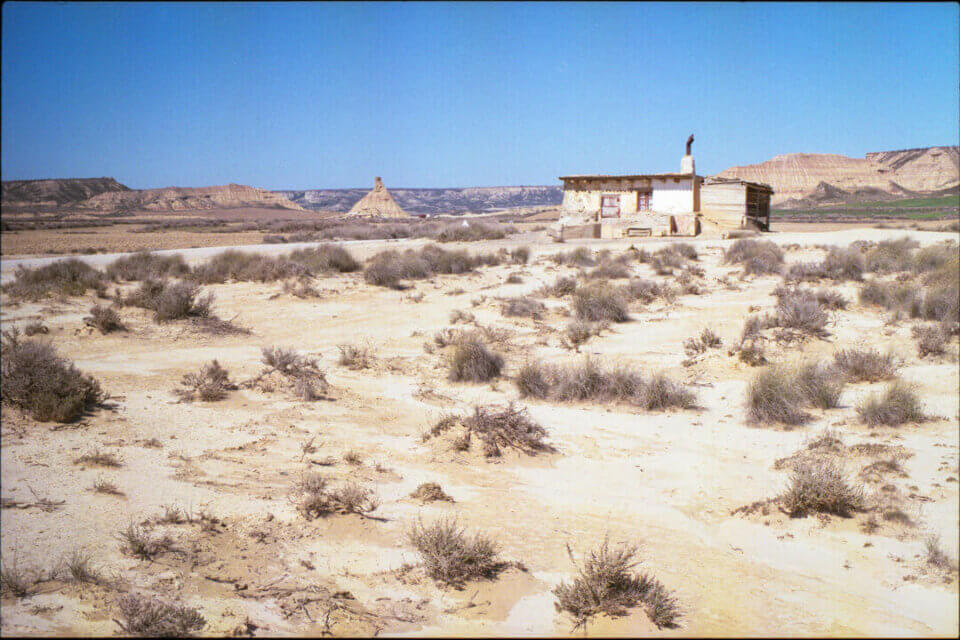
To sum up, my biggest fear in Morocco was getting stranded somewhere high up in the mountains with a punctured tyre or tuning the carburettor every 5 minutes due to high temperatures. Luckily I experienced none of those. In fact, the only things I had to do when it comes to bike maintenance was to change the oil before I entered Morocco, change a headlight, indicator and stoplight bulbs and keep the chain clean, lubed and tensioned pretty much at all times. That’s really all the jobs I had to do on a 4000 mile journey. Now when I think of it, I could’ve left so many spare parts and tools at home and taken a tent instead, which happened to be the only thing I needed and did not have.
So that I’m not accused of sugarcoating, I admit I broke one of the indicators by constantly rubbing a saddle bag against it and one of the foot pegs became loose from hours of standing. A rear brake switch stopped working as too much sand and grime got inside it and some indicator wires under the rear fender got exposed due to the tyre rubbing against them – easy fix with some electrical tape. Speaking of tyres – my rear Dunlop K82 went almost completely bald. It’s normal that some things were worn down along the way but luckily none of them stopped me from moving forward. Going back to the question on how did the Classic 125 handle the different terrains, I’ll say it did absolutely great!
Q: What were your most memorable moments of the journey?
Ohh, there were so many! I remember quite well pretty much every day of riding and every little town I visited. I never used the same road twice, each day welcomed me with different scenery and a different set of challenges, so there was always something new to remember every single day. But to answer your question let me start with something trivial like riding at night. There was one particular town in Spain called Torreorgaz where I stayed for the night and left while it was still dark. I rode under an unbelievably starry sky for almost an hour and every now and then a thick layer of fog covered the tarmac. I know now there were some lakes and small rivers nearby but back then in the dark I had no idea where that fog was coming from. It just felt magical.
I find it too risky to ride till late, so if it wasn’t for my early get ups I’d probably never even see a cloudless sky filled with stars from under a motorcycle helmet. And to top it off, instead of anxiety and fatigue that hit naturally at night I was being rewarded with beautiful sunrises slowly revealing
the unknown. My first few days on Spanish soil were exactly like that – riding into the morning twilight.
Then there was the Valley of Ziz in Morocco – I think the most beautiful place one could go to. Coming from Sefrou – a little town near Fes – I chose some secluded and less popular roads that crossed the mountains and I slowly entered the desert for the first time. Soon the valley similiar to the Canyons of Colorado appeared infront of me and after a bit of searching I found a traditional berber home where I stayed for the night. I ate some delicious harira soup while I watched the home owner’s son playing with my bike and the sun setting behind the orange cliffs. After eight days of constant riding I was finally where I wanted to be and just couldn’t stop smiling to myself.

Two other things I will remember forever, although for slightly different reasons, was getting into a sandstorm near Alnif and going up the R703 and R704 roads in the High Atlas mountains.
Once I left Merzouga, I stopped for a few hours at Gara Medouar, which was a fascinating crater-like rock formation in the middle of nowhere. Some say it used to be a Portuguese prison, in one of his recent movies James Bond claims it’s Bloefeld’s secret hideaway. I only wanted to see the place as it involved some off-road riding and I wanted to hide a letter I wrote to my son for him to find when he gets older and starts travelling. He was only one month old at that time, bless my wife for letting me go.
Once I hid the letter, I went back on tarmac and it didn’t take long till I noticed tiny whirlwinds forming on the side of the road. It was quite fascinating, especially when bigger ones appeared in front of me. As the wind got stronger they all soon vanished while the sky on my right turned dark like it was going to rain. To keep a long story short, the rain never came. It was an actual sandstorm heading my way and I was kind of lucky/unlucky to experience it. Of course now it sounds cool and makes a great story, but at the time I was really scared as the sand was getting everywhere. The road to Alnif was slightly inclining at first, I had like 30kgs of luggage on my bike and I was worried that if somehow the dust finds its way into the carb I may not be able to start it again. I soon discovered it was simply the wind that kept stopping me and once I was on the flat everything was fine. When I rode into Alnif the place looked like a deserted ghost town, the whole thing lasted for about half an hour but it will definitely last forever in my memory.
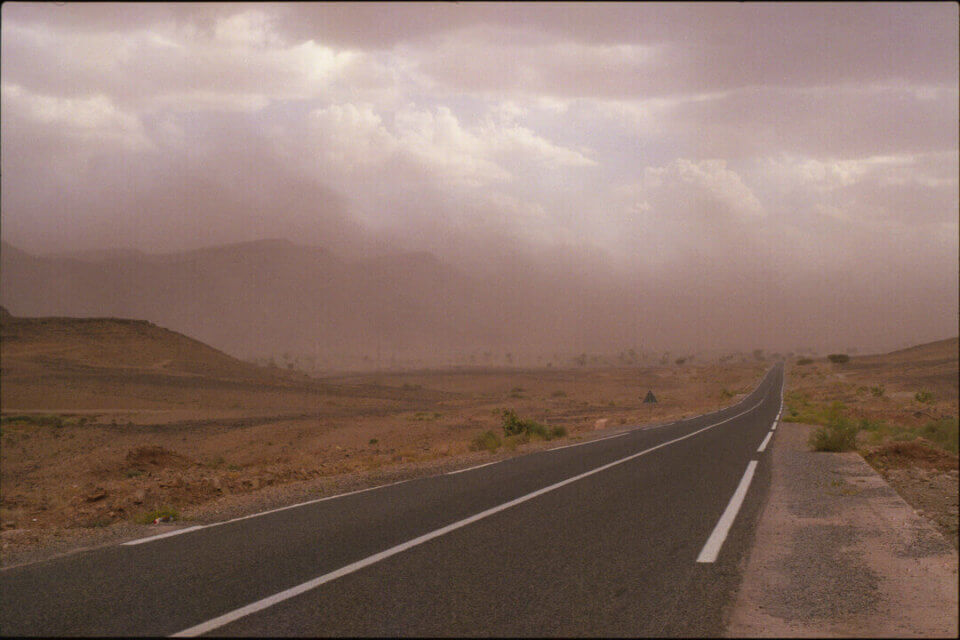
Now the R703 and R704. These are high altitude mountain roads that connect the Valley of Todra, a small village of Agoudal up in the mountains and the Valley of Dades. Most bikers who plan on touring Morocco have heard of at least the latter one – the famous twisties going through the Dades Gorge is probably the most photographed place among motorised tourists. The thing is that most of them come up from the southwest just to see the hairpins and head back or continue through the main roads towards the Todra Gorge. Since I was coming from a different direction, my idea was to climb up the steep and twisty R703 through Tizi n’Tirherhouzine pass (2.675m) and then, in Agoudal, jump onto the northern tip of R704 – a road many consider the most dangerous in Morocco.

On most of its length the R703 is basically a single track made of nothing but dirt, gravel and rocks that runs through the mountain slopes where huge drops await for anyone who is not careful enough. I rode through the Lake District’s Hardknott Pass as an unexperienced rider within the first
couple of months of my time with Herald and spent a few days on those crazy buses that go through Nepal and the mountainous regions of northern India, but this was just something else. The highest pass on the route was Tizi n’Ouano at 2.910m but at one point, even long before reaching the pass, I had to come off and push the bike on foot while keeping a steady hand on the throttle only because it was so steep that I was scared of coming off the cliff.
A 125-mile distance took me eight long hours, while half of that time I spent only on the 35-mile stretch of unpaved “le piste” as they call it in French. The only vehicles I saw was a group of three oncoming off-road campers when we had a really hard time passing each other. Then just as the sun was setting and I was cooking a meal on the side of the road, two Land Cruisers came onto the dirt and I kept wondering if they knew what they were getting themselves into traversing that road under moonlight.

Q: What advice would you give to new riders planning their first adventure?
There’s a lot of questions you have to ask yourself before going on an adventure. Things like the budget, the level of comfort, the choice between highways and B roads and so on are very individual. I travelled on the cheap but still spent (almost) all my nights in hotel rooms. I ate freeze dried meals cooked on a stove when stopping on the way, yet still dined out once I was at the destination. I also stuck to the B roads to immerse myself in local scenery although I know now that I should’ve been more flexible and would benefit from going onto a highway every now and then.
We all know that motorcycling is not that easy, right? And travelling long distances on a motorcycle day after day is even more demanding – both physically and mentally. So in my opinion by gathering information before the trip one can eliminate most problems before they arise. You can still decide later what your travelling style is going to be and how organised you want to be vs. how much room for spontaneity you want to leave. But there has to be some basic knowledge first to make those conscious decisions.
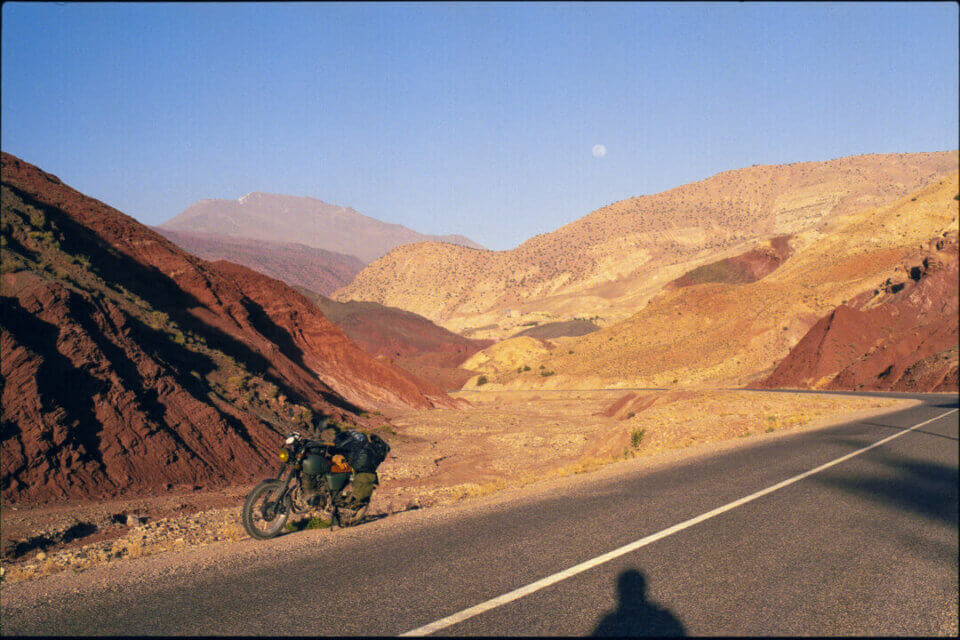
I’d recommend getting your bike into the best mechanical shape it can be. Find out what are the most common issues with your model and see if you have the skills and tools to fix them. If not, which is fine because not everyone has to be a mechanic, take some extra money in case you need repairs. Change the tyres, chain and sprockets, worn out brake pads and maybe even clutch and throttle cables. Clean the carburettor if you know how to and charge the battery. Basically, replace whatever you can before it breaks, especially if you haven’t done it in the recent past. Something might still break on the way, but at least you’ll minimise that risk.
I had a route plan made for every single day of riding including details such as distance I needed to cover, temperature, pit stops, and documentation required for crossing borders and I always familiarised myself with it the night before. I always knew by what time I needed to get up and leave to arrive on time, I knew where I was heading, what towns were on the way and what clothes I should’ve prepared. All this just to keep my mind at peace as much as possible so I could focus exclusively on enjoying the ride.
I still lost my way once while riding from Seville to Jerez de la Frontera in southern Spain – it was so hot that my iPhone shut down and the road I took was too small to be marked on my paper map. Afew times I was also freezing during those early morning rides and then melting in the afternoon sun, these were just small accidents but I feel like if I didn’t do my homework at all they could have quickly become daily nightmares.

Q: Do you have any plans for future adventures?
Of course! The desert rat definitely needs some hot air flowing through the carburettor again so last year I started planning a journey to Tunisia. The pandemic has put an end to it, but only temporarily I hope. This time I would like to cross some parts of France I haven’t seen before, ride through the Swiss Alps, go along the entire Italian coast and after boarding a ferry in Sicily I’d end up in North Africa again. Tunisia may not be as big or as diverse as Morocco but there’s a lot of beautiful places worth visiting and the countries on the way offer even more attractions, so I know I would have a lot of fun travelling there. This time I’d take a bit less stuff but definitely pack a tent!
If somehow that doesn’t work out, maybe I’ll get around to finally ride the Scottish NC500? The dream trip however, if I may share this idea with you, would be to visit Iran. It’s a huge and beautiful country and all I keep hearing is how friendly it is for motorcycle travellers. Seems far for a 125cc, but then again, someone told me the same about Morocco!

If we have learnt anything from recent years, it is that the opportunity to break boundaries, face adversity and push yourself to heights you may have thought were unreachable should be welcomed with open arms.
Kordian’s journey, which many may not attempt on anything less than a high spec adventure bike riddled with electronically assisted controls, is the perfect example of overcoming adversity and we are extremely proud the Classic 125 took part in this inspirational adventure.
